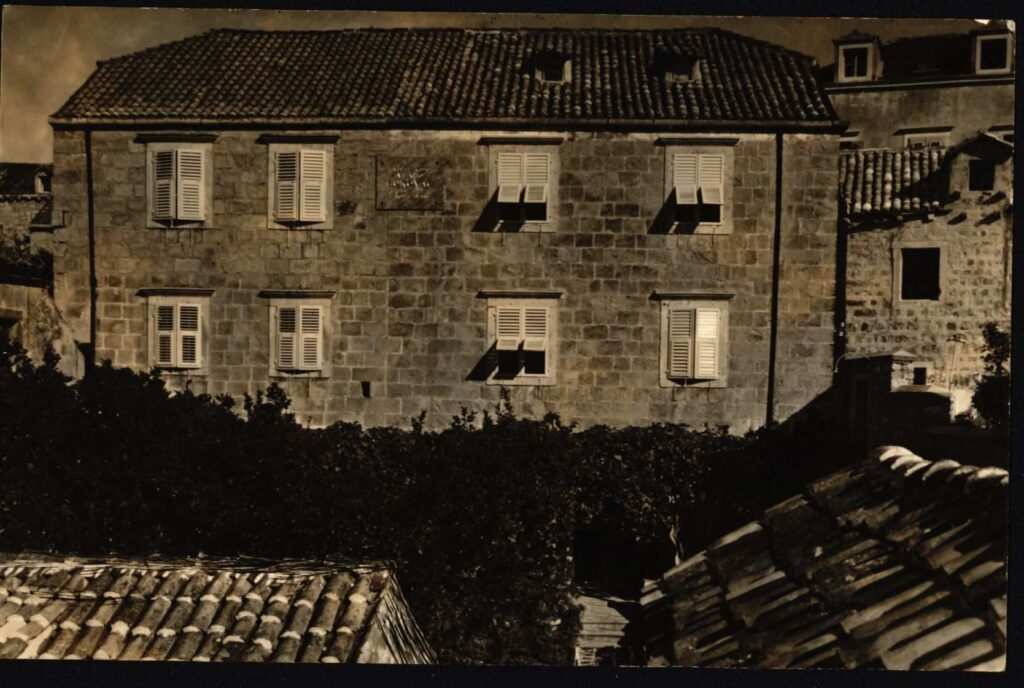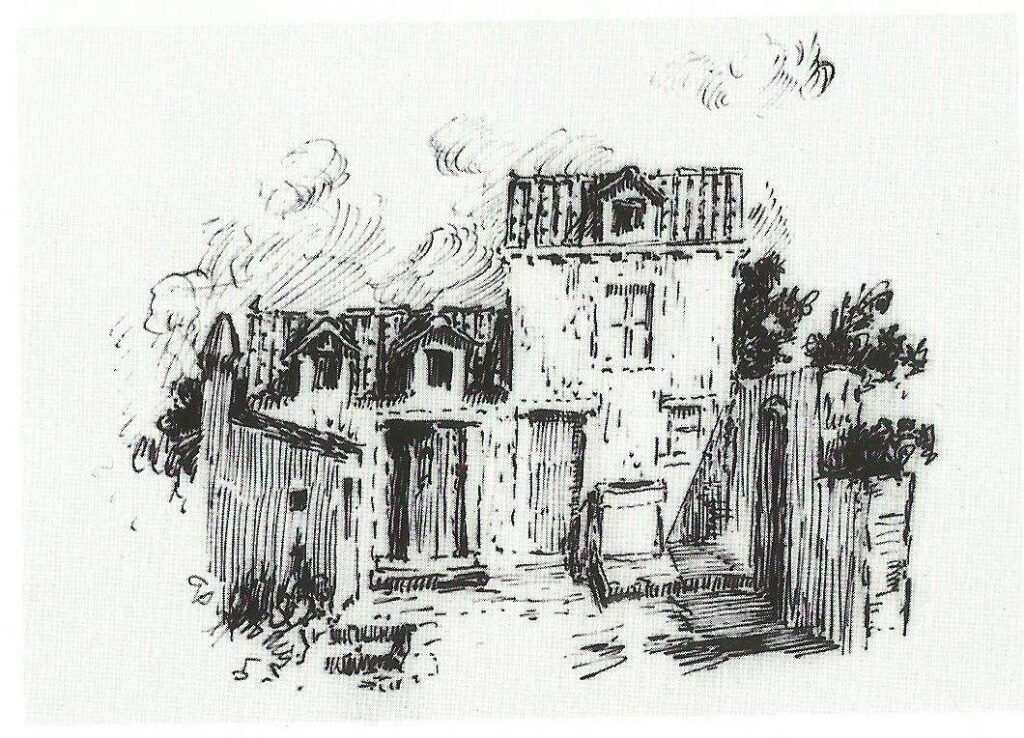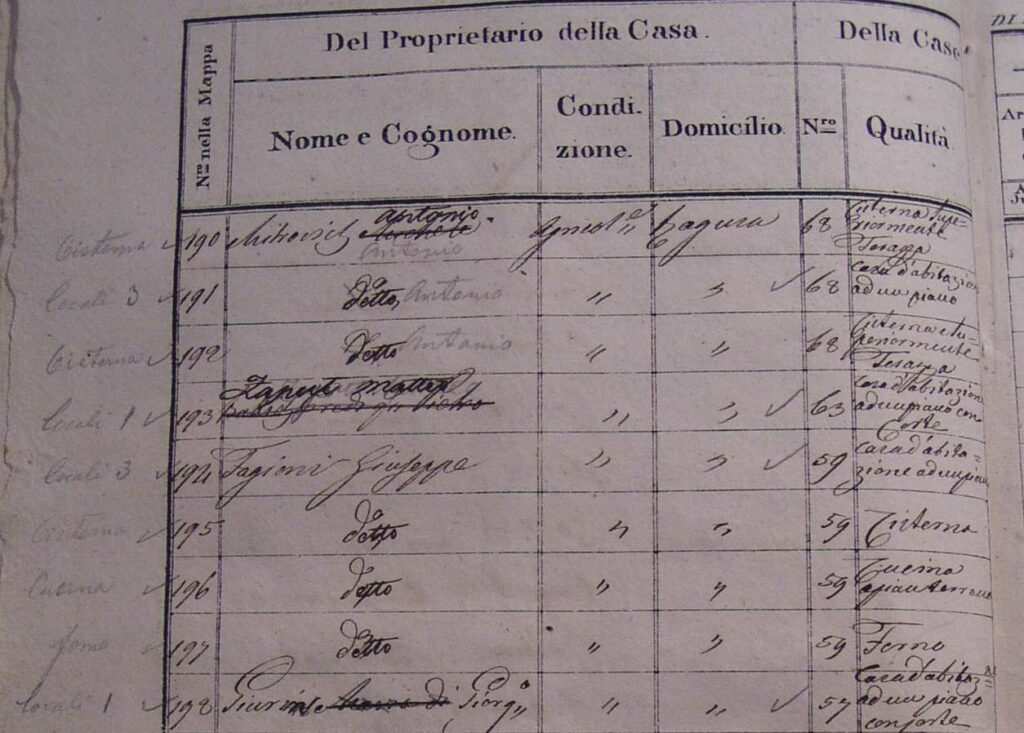In the early 19th century, Giuseppe Faggioni, an Italian sailor from the Genoa area and the grandfather of Vlaho Bukovac, sailed into the port of Cavtat. The exact reason for his prolonged stay in Cavtat has remained unknown – it is speculated to have been either a storm or a ship repair. What is known, however, is that during his stay he met Ana Kličan, a local girl who would become his wife in 1807. The Faggioni family would eventually assume an important role in the town’s social and cultural life.
The name of Giuseppe Faggioni can be found in the cadastral maps and books from 1837, listing him as the owner of a one-story house with a cistern, a ground floor kitchen and a bread oven. In addition to the plot that occupies the eastern part of today’s House Bukovac, the Faggioni family owned a number of other properties in Cavtat. In the place of the western part of today’s House Bukovac, as shown on the aforementioned cadastral maps, a ruin with a cistern was once located.
The above-mentioned small one-story house, which Vlaho Bukovac drew from memory in order to use the drawing as a cover illustration for his autobiography, was upgraded by his father around 1872. This was the time when the 17-year-old Vlaho, having returned from his maritime voyage due to a head injury, left his unique mark on the freshly plastered walls with his wall paintings, which are slowly regaining their old splendour after almost 150 years.
The aforementioned construction works conducted by Augustino Faggioni, Vlaho Bukovac’s father, can be traced on the cadastral map of Cavtat from 1876. It can be seen that the spatial disposition of the eastern part of the house has its present appearance; the same can be said for the entrance terrace, featuring a central entrance staircase, raised earthen surfaces bordered by walls and a paved promenade in front of the façade.
It would not be long before the family bought the aforementioned ruin with a cistern and adjoined it to the eastern part of the house. The spacious ground floor room, today an exhibition space, was used as a storage room. Although Bukovac’s father was the one who most likely added an extra floor to the house, it was Vlaho Bukovac himself who would be responsible for its present appearance. Around 1900, he built an art studio above the dining room. On the north side, the studio is lighted by a large window covering almost the entirety of the wall and by a door accessing a wooden walkway that leads directly from the studio to the back garden. He united these two once separate buildings into a unified whole and the house gained its present appearance. The construction of the studio took place during Bukovac’s four-year residence in Cavtat upon returning home from Zagreb in 1898; he subsequently relocated to Vienna in 1902, only to relocate to Prague in the following year. Bukovac would go on to spend the remainder of his life in Prague, visiting Cavtat one last time in 1920.
As can be seen from the letters from Bukovac’s friend Gjorgji Bijelić to Bukovac himself, the painter’s studio was, in his absence, open to any interested visitors during the First World War. After Bukovac’s death, his family continued this tradition and thus their efforts to establish the Vlaho Bukovac Memorial Museum intensified. In 1963, a purchase agreement was finally signed between the Yugoslav Academy of Sciences and Arts and the heirs to Bukovac’s legacy; the house and its inventory were purchased, while the efforts of the art historian and conservator Cvito Fisković secured the establishment of a special unit within the framework of The Institute for Historical Sciences of the Yugoslav Academy of Sciences and Arts, the Vlaho Bukovac Memorial Museum, later renamed into the Vlaho Bukovac Memorial Collection.
However, an entire decade would pass before the Vlaho Bukovac Art Gallery was finally opened in 1976 as part of the Dubrovnik Art Gallery; the gallery was housed on the second floor of the Bukovac house. It was open until the beginning of the Croatian War of Independence in 1991, when the paintings were evacuated to Dubrovnik. The ownership of the Bukovac house was transferred to the Municipality of Konavle, which was founded in 1993. Today, the Bukovac house is currently owned by the Museums and Galleries of Konavle, a cultural institution founded in 1997.
Shortly after the establishment of the aforementioned institution, extensive renovation of the building was launched. During the excavation of the ground in the garden on the north side of the house in order to create space for a museum storage room, a significant number of different fragmented finds were uncovered, confirming the continuity of life in such a small locale since ancient times. Beneath the earthen layer, at a depth of about two meters, a large number of tegulae and imbrexes (Roman tiles) began to appear, and then the floor level of a Roman house was reached. In addition to the building elements (the floor, a part of the plastered wall, tegulae), which helped determine the exact location of the house on the plot, several complete movable finds were uncovered: a small house altar, a ceramic cup, a bowl made of bone, etc. The restoration of the newly discovered wall art was also in progress at that time and the house was reopened to the general public in 2004.
Today, the Bukovac House, as a museum space exhibiting the famous painter’s rich legacy, is open to visitors in its entirety. Its museological concept is based on the intertwining of two basic principles of such a space – that of a family house, as well as that of a museum.



